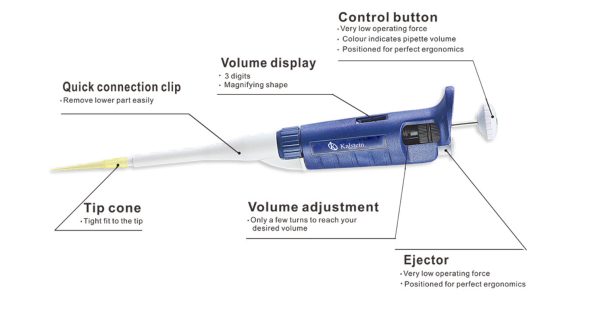Pipettes are a very useful tool for transferring liquids from one container to another. They can be used to transfer liquids from one bottle to another, or to transfer liquids from one test piece to another. Also to take fluid samples for analysis.
They are also made from a variety of materials, including glass, plastic, and metal. Glass pipettes are the most common and can be found in most laboratories. Plastic ones are cheaper than glass ones and are lighter, making them easier to use. Metal rods are more resistant to heat and corrosion, so they are used in some specialized laboratories.
At Kalstein we have suitable and fully resistant pipettes, they are used in a wide range of applications in the laboratory, and are especially useful for sample preparation and chemical reactions. They are also used in biology and medicine research, and are often used for DNA and protein synthesis.
Correct use of pipettes
A pipette is an instrument used to transfer liquids from one container to another, or to measure liquids accurately. They are used in many areas of science, such as chemistry, biology and medicine.
To use, the tip of the pipette should be placed in the liquid to be transferred. Then, aspirate the fluid using the mouthpiece and keep the end below the level of the fluid. To transfer the liquid to another container, the nozzle should be pressed lightly, using a graduated pipette, which has a mark indicating the amount of liquid that has been aspirated. In the case of glass pipettes commonly used in laboratories they should be handled with care to avoid breaking.
Automatic pipettes are electronic instruments used to accurately transfer liquids, which can be adjusted to dispense liquids in small quantities, making them ideal for laboratory applications where precision is required. They are used in many areas of science to accurately transfer or measure liquids.
Tips for proper handling of Pipettes in the laboratory
Pipettes are a very useful tool in the laboratory, but they can also be a little tricky to manipulate. If you’re having trouble handling pipettes, here are some tips to help:
The first thing you need to do is make sure the Pipettes are clean. Before using, make sure they are free of dust and any other debris.
Make sure they are calibrated before using them. This is especially important if you are working with corrosive liquids or toxins.
When you fill them up, make sure it’s not too much. If the liquid is spilled, it can damage the equipment or cause accidents.
Use proper technique to manipulate them. Make sure your hands are clean and dry before touching them.
Breathe out gently while holding the pipette. This will stop the liquid from spilling out.
Dissolve any foam that forms in the liquid before aspirating it.
Wash after use. Make sure they are completely clean before storing.
Following these tips, it will be much easier for you to handle the pipettes safely and effectively.
Kalstein pipettes
We at Kalstein invite you to know our wide range of excellent quality equipment fully trained for all kinds of laboratory. And on this occasion, we offer you the Pipettes belonging to the YR series, they are made of glass or plastic and are equipped with a funnel or mouth to fill them easily, and a graduation indicating the volume of liquid they contain. If you want to know more about our catalog visit HERE We are manufacturers and we have the best advice, so that your purchase is the ideal and at excellent prices. Visit HERE

